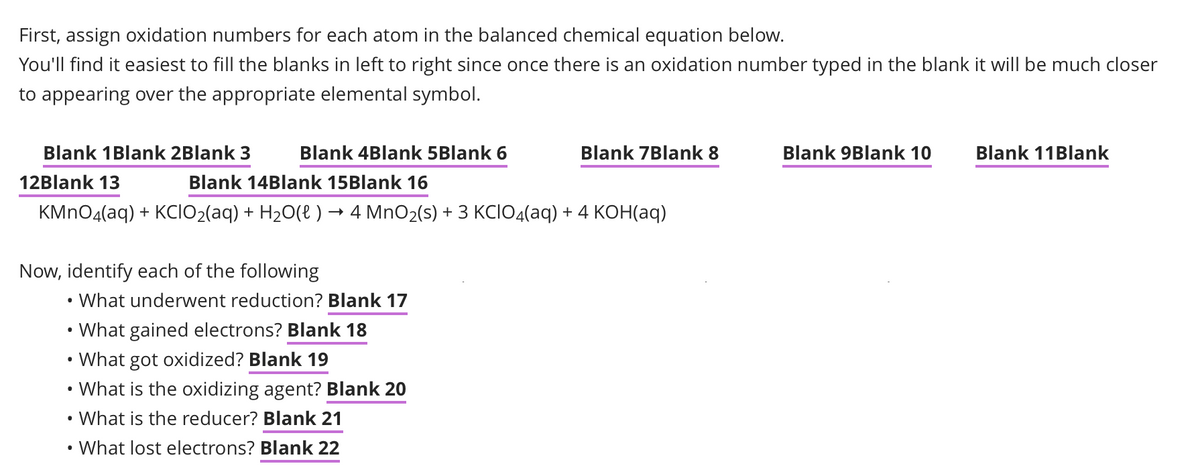First, assign oxidation numbers for each atom in the balanced chemical equation below. You'll find it easiest to fill the blanks in left to right since once there is an oxidation number typed in the blank it will be much closer to appearing over the appropriate elemental symbol. Blank 1 Blank 2Blank 3 12Blank 13 Blank 4Blank 5Blank 6 Blank 14Blank 15Blank 16 KMnO4(aq) + KCIO₂(aq) + H₂O(l) → 4 MnO₂(s) + 3 KCIO4(aq) + 4 KOH(aq) Now, identify each of the following • What underwent reduction? Blank 17 Blank 7Blank 8 • What gained electrons? Blank 18 • What got oxidized? Blank 19 • What is the oxidizing agent? Blank 20 • What is the reducer? Blank 21 What lost electrons? Blank 22 Blank 9Blank 10 Blank 11Blank
First, assign oxidation numbers for each atom in the balanced chemical equation below. You'll find it easiest to fill the blanks in left to right since once there is an oxidation number typed in the blank it will be much closer to appearing over the appropriate elemental symbol. Blank 1 Blank 2Blank 3 12Blank 13 Blank 4Blank 5Blank 6 Blank 14Blank 15Blank 16 KMnO4(aq) + KCIO₂(aq) + H₂O(l) → 4 MnO₂(s) + 3 KCIO4(aq) + 4 KOH(aq) Now, identify each of the following • What underwent reduction? Blank 17 Blank 7Blank 8 • What gained electrons? Blank 18 • What got oxidized? Blank 19 • What is the oxidizing agent? Blank 20 • What is the reducer? Blank 21 What lost electrons? Blank 22 Blank 9Blank 10 Blank 11Blank
Chemistry: The Molecular Science
5th Edition
ISBN:9781285199047
Author:John W. Moore, Conrad L. Stanitski
Publisher:John W. Moore, Conrad L. Stanitski
Chapter3: Chemical Reactions
Section: Chapter Questions
Problem 113QRT
Related questions
Question
100%

Transcribed Image Text:First, assign oxidation numbers for each atom in the balanced chemical equation below.
You'll find it easiest to fill the blanks in left to right since once there is an oxidation number typed in the blank it will be much closer
to appearing over the appropriate elemental symbol.
Blank 1 Blank 2Blank 3
12Blank 13
Blank 4Blank 5Blank 6
Blank 14Blank 15Blank 16
KMnO4(aq) + KCIO₂(aq) + H₂O(l) → 4 MnO₂(s) + 3 KCIO4(aq) + 4 KOH(aq)
Now, identify each of the following
What underwent reduction? Blank 17
Blank 7Blank 8
What gained electrons? Blank 18
• What got oxidized? Blank 19
What is the oxidizing agent? Blank 20
• What is the reducer? Blank 21
What lost electrons? Blank 22
Blank 9Blank 10
Blank 11 Blank
Expert Solution
This question has been solved!
Explore an expertly crafted, step-by-step solution for a thorough understanding of key concepts.
Step by step
Solved in 2 steps with 2 images

Knowledge Booster
Learn more about
Need a deep-dive on the concept behind this application? Look no further. Learn more about this topic, chemistry and related others by exploring similar questions and additional content below.Recommended textbooks for you

Chemistry: The Molecular Science
Chemistry
ISBN:
9781285199047
Author:
John W. Moore, Conrad L. Stanitski
Publisher:
Cengage Learning

Chemistry & Chemical Reactivity
Chemistry
ISBN:
9781337399074
Author:
John C. Kotz, Paul M. Treichel, John Townsend, David Treichel
Publisher:
Cengage Learning

Chemistry & Chemical Reactivity
Chemistry
ISBN:
9781133949640
Author:
John C. Kotz, Paul M. Treichel, John Townsend, David Treichel
Publisher:
Cengage Learning

Chemistry: The Molecular Science
Chemistry
ISBN:
9781285199047
Author:
John W. Moore, Conrad L. Stanitski
Publisher:
Cengage Learning

Chemistry & Chemical Reactivity
Chemistry
ISBN:
9781337399074
Author:
John C. Kotz, Paul M. Treichel, John Townsend, David Treichel
Publisher:
Cengage Learning

Chemistry & Chemical Reactivity
Chemistry
ISBN:
9781133949640
Author:
John C. Kotz, Paul M. Treichel, John Townsend, David Treichel
Publisher:
Cengage Learning

Chemistry: Matter and Change
Chemistry
ISBN:
9780078746376
Author:
Dinah Zike, Laurel Dingrando, Nicholas Hainen, Cheryl Wistrom
Publisher:
Glencoe/McGraw-Hill School Pub Co

Introductory Chemistry: A Foundation
Chemistry
ISBN:
9781337399425
Author:
Steven S. Zumdahl, Donald J. DeCoste
Publisher:
Cengage Learning

World of Chemistry, 3rd edition
Chemistry
ISBN:
9781133109655
Author:
Steven S. Zumdahl, Susan L. Zumdahl, Donald J. DeCoste
Publisher:
Brooks / Cole / Cengage Learning